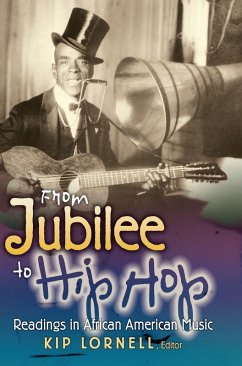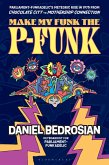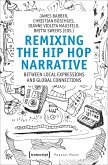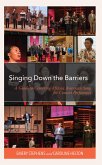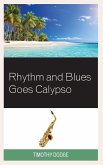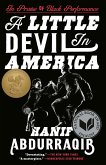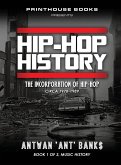- Gebundenes Buch
- Merkliste
- Auf die Merkliste
- Bewerten Bewerten
- Teilen
- Produkt teilen
- Produkterinnerung
- Produkterinnerung
Includes 36 reading selections that underscore the breath and variety of African American musical culture. Each selection relates something notable and interesting about African American musical culture since the Emancipation.
Andere Kunden interessierten sich auch für
![Make My Funk the P-Funk Make My Funk the P-Funk]() Daniel BedrosianMake My Funk the P-Funk34,99 €
Daniel BedrosianMake My Funk the P-Funk34,99 €![Remixing the Hip Hop Narrative Remixing the Hip Hop Narrative]() Remixing the Hip Hop Narrative30,99 €
Remixing the Hip Hop Narrative30,99 €![Singing Down the Barriers Singing Down the Barriers]() Emery StephensSinging Down the Barriers88,99 €
Emery StephensSinging Down the Barriers88,99 €![Rhythm and Blues Goes Calypso Rhythm and Blues Goes Calypso]() Timothy DodgeRhythm and Blues Goes Calypso113,99 €
Timothy DodgeRhythm and Blues Goes Calypso113,99 €![Rhythm and Blues Goes Calypso Rhythm and Blues Goes Calypso]() Timothy DodgeRhythm and Blues Goes Calypso44,99 €
Timothy DodgeRhythm and Blues Goes Calypso44,99 €![A Little Devil in America A Little Devil in America]() Hanif AbdurraqibA Little Devil in America16,99 €
Hanif AbdurraqibA Little Devil in America16,99 €![HIP-HOP History (Book 1 of 3) HIP-HOP History (Book 1 of 3)]() Antwan 'Ant' Bank$HIP-HOP History (Book 1 of 3)67,99 €
Antwan 'Ant' Bank$HIP-HOP History (Book 1 of 3)67,99 €-
-
-
Includes 36 reading selections that underscore the breath and variety of African American musical culture. Each selection relates something notable and interesting about African American musical culture since the Emancipation.
Produktdetails
- Produktdetails
- Verlag: Routledge
- Seitenzahl: 416
- Erscheinungstermin: 3. Juli 2017
- Englisch
- Abmessung: 250mm x 175mm x 27mm
- Gewicht: 894g
- ISBN-13: 9781138401402
- ISBN-10: 1138401404
- Artikelnr.: 48954566
- Herstellerkennzeichnung
- Libri GmbH
- Europaallee 1
- 36244 Bad Hersfeld
- gpsr@libri.de
- Verlag: Routledge
- Seitenzahl: 416
- Erscheinungstermin: 3. Juli 2017
- Englisch
- Abmessung: 250mm x 175mm x 27mm
- Gewicht: 894g
- ISBN-13: 9781138401402
- ISBN-10: 1138401404
- Artikelnr.: 48954566
- Herstellerkennzeichnung
- Libri GmbH
- Europaallee 1
- 36244 Bad Hersfeld
- gpsr@libri.de
Kip Lornell, Editor, The George Washington University
Preface Introduction Black American Music Since Reconstruction: An Overview
1 Adrift on Stormy Seas 2 Richards and Pringle's Original Georgia Minstrels
and Billy Kersands, 1889-1895 3 The Virginia Jubilee Singers in Bourke,
Australia 4 African Banjo Echoes in Appalachia: A Conclusion 5 War on
Ragtime and Suppression of "Ragtime" 6 Of the Sorrow Songs 7 The
Nineteenth-Century Origins of Jazz 8 Marshall Lullaby 9 The Scene and the
Players in New York 10 Jelly Roll Blues 11 William Marion Cook 12 Ma Rainey
and the Traveling Minstrels 13 Black Sacred Harp Singing from Southeast
Alabama 14 A Negro Explains "Jazz" 15 Paul Robeson, Musician 16 Conflict
and Resolution in the Life of Thomas Andrew Dorsey 17 Fats Waller (Comedy
Tonight) 18 "Dean of Afro-American Composers" or "Harlem Renaissance Man":
The New Negro and the Musical Poetics of William Grant Still 19 Easter
Sunday 20 Caldonia 21 Elder Beck's Temple 22 T-Bone Blues: T-Bone Walker's
Story in His Own Words 23 The Impact of Gospel Music on the Secular Music
Industry 24 Singing in the Streets of Raleigh, 1963: Some Recollections 25
Motown Calls "The Rock & Roll Kid" 26 Respect: 1964-1965 27 Clifton
Chenier: "They Call Me the King" 28 The Art of the Muscle: Miles Davis as
American Knight and American Knave 29 Evaluating Ellington 30 The P-Funk
Empire: Tear the Roof Off the Sucker 31 Hip-Hop, Puerto Ricans, and
Ethnoracial Identities in New York32 Daughters of the Blues: Women, Race,
and Class Representation in Rap Music Performance 33 Media Interventions 34
Black Artistic Invisibility: A Black Composer Talking 'bout Taking Care of
the Souls of Black Folks While Losing Much Ground Fast 35 Stepping Out an
African Heritage 36 Rhythm and Bullshit? The Slow Decline of R&B
1 Adrift on Stormy Seas 2 Richards and Pringle's Original Georgia Minstrels
and Billy Kersands, 1889-1895 3 The Virginia Jubilee Singers in Bourke,
Australia 4 African Banjo Echoes in Appalachia: A Conclusion 5 War on
Ragtime and Suppression of "Ragtime" 6 Of the Sorrow Songs 7 The
Nineteenth-Century Origins of Jazz 8 Marshall Lullaby 9 The Scene and the
Players in New York 10 Jelly Roll Blues 11 William Marion Cook 12 Ma Rainey
and the Traveling Minstrels 13 Black Sacred Harp Singing from Southeast
Alabama 14 A Negro Explains "Jazz" 15 Paul Robeson, Musician 16 Conflict
and Resolution in the Life of Thomas Andrew Dorsey 17 Fats Waller (Comedy
Tonight) 18 "Dean of Afro-American Composers" or "Harlem Renaissance Man":
The New Negro and the Musical Poetics of William Grant Still 19 Easter
Sunday 20 Caldonia 21 Elder Beck's Temple 22 T-Bone Blues: T-Bone Walker's
Story in His Own Words 23 The Impact of Gospel Music on the Secular Music
Industry 24 Singing in the Streets of Raleigh, 1963: Some Recollections 25
Motown Calls "The Rock & Roll Kid" 26 Respect: 1964-1965 27 Clifton
Chenier: "They Call Me the King" 28 The Art of the Muscle: Miles Davis as
American Knight and American Knave 29 Evaluating Ellington 30 The P-Funk
Empire: Tear the Roof Off the Sucker 31 Hip-Hop, Puerto Ricans, and
Ethnoracial Identities in New York32 Daughters of the Blues: Women, Race,
and Class Representation in Rap Music Performance 33 Media Interventions 34
Black Artistic Invisibility: A Black Composer Talking 'bout Taking Care of
the Souls of Black Folks While Losing Much Ground Fast 35 Stepping Out an
African Heritage 36 Rhythm and Bullshit? The Slow Decline of R&B
Preface Introduction Black American Music Since Reconstruction: An Overview 1 Adrift on Stormy Seas 2 Richards and Pringle's Original Georgia Minstrels and Billy Kersands, 1889-1895 3 The Virginia Jubilee Singers in Bourke, Australia 4 African Banjo Echoes in Appalachia: A Conclusion 5 War on Ragtime and Suppression of "Ragtime" 6 Of the Sorrow Songs 7 The Nineteenth-Century Origins of Jazz 8 Marshall Lullaby 9 The Scene and the Players in New York 10 Jelly Roll Blues 11 William Marion Cook 12 Ma Rainey and the Traveling Minstrels 13 Black Sacred Harp Singing from Southeast Alabama 14 A Negro Explains "Jazz" 15 Paul Robeson, Musician 16 Conflict and Resolution in the Life of Thomas Andrew Dorsey 17 Fats Waller (Comedy Tonight) 18 "Dean of Afro-American Composers" or "Harlem Renaissance Man": The New Negro and the Musical Poetics of William Grant Still 19 Easter Sunday 20 Caldonia 21 Elder Beck's Temple 22 T-Bone Blues: T-Bone Walker's Story in His Own Words 23 The Impact of Gospel Music on the Secular Music Industry 24 Singing in the Streets of Raleigh, 1963: Some Recollections 25 Motown Calls "The Rock & Roll Kid" 26 Respect: 1964-1965 27 Clifton Chenier: "They Call Me the King" 28 The Art of the Muscle: Miles Davis as American Knight and American Knave 29 Evaluating Ellington 30 The P-Funk Empire: Tear the Roof Off the Sucker 31 Hip-Hop, Puerto Ricans, and Ethnoracial Identities in New York32 Daughters of the Blues: Women, Race, and Class Representation in Rap Music Performance 33 Media Interventions 34 Black Artistic Invisibility: A Black Composer Talking 'bout Taking Care of the Souls of Black Folks While Losing Much Ground Fast 35 Stepping Out an African Heritage 36 Rhythm and Bullshit? The Slow Decline of R&B
Preface Introduction Black American Music Since Reconstruction: An Overview
1 Adrift on Stormy Seas 2 Richards and Pringle's Original Georgia Minstrels
and Billy Kersands, 1889-1895 3 The Virginia Jubilee Singers in Bourke,
Australia 4 African Banjo Echoes in Appalachia: A Conclusion 5 War on
Ragtime and Suppression of "Ragtime" 6 Of the Sorrow Songs 7 The
Nineteenth-Century Origins of Jazz 8 Marshall Lullaby 9 The Scene and the
Players in New York 10 Jelly Roll Blues 11 William Marion Cook 12 Ma Rainey
and the Traveling Minstrels 13 Black Sacred Harp Singing from Southeast
Alabama 14 A Negro Explains "Jazz" 15 Paul Robeson, Musician 16 Conflict
and Resolution in the Life of Thomas Andrew Dorsey 17 Fats Waller (Comedy
Tonight) 18 "Dean of Afro-American Composers" or "Harlem Renaissance Man":
The New Negro and the Musical Poetics of William Grant Still 19 Easter
Sunday 20 Caldonia 21 Elder Beck's Temple 22 T-Bone Blues: T-Bone Walker's
Story in His Own Words 23 The Impact of Gospel Music on the Secular Music
Industry 24 Singing in the Streets of Raleigh, 1963: Some Recollections 25
Motown Calls "The Rock & Roll Kid" 26 Respect: 1964-1965 27 Clifton
Chenier: "They Call Me the King" 28 The Art of the Muscle: Miles Davis as
American Knight and American Knave 29 Evaluating Ellington 30 The P-Funk
Empire: Tear the Roof Off the Sucker 31 Hip-Hop, Puerto Ricans, and
Ethnoracial Identities in New York32 Daughters of the Blues: Women, Race,
and Class Representation in Rap Music Performance 33 Media Interventions 34
Black Artistic Invisibility: A Black Composer Talking 'bout Taking Care of
the Souls of Black Folks While Losing Much Ground Fast 35 Stepping Out an
African Heritage 36 Rhythm and Bullshit? The Slow Decline of R&B
1 Adrift on Stormy Seas 2 Richards and Pringle's Original Georgia Minstrels
and Billy Kersands, 1889-1895 3 The Virginia Jubilee Singers in Bourke,
Australia 4 African Banjo Echoes in Appalachia: A Conclusion 5 War on
Ragtime and Suppression of "Ragtime" 6 Of the Sorrow Songs 7 The
Nineteenth-Century Origins of Jazz 8 Marshall Lullaby 9 The Scene and the
Players in New York 10 Jelly Roll Blues 11 William Marion Cook 12 Ma Rainey
and the Traveling Minstrels 13 Black Sacred Harp Singing from Southeast
Alabama 14 A Negro Explains "Jazz" 15 Paul Robeson, Musician 16 Conflict
and Resolution in the Life of Thomas Andrew Dorsey 17 Fats Waller (Comedy
Tonight) 18 "Dean of Afro-American Composers" or "Harlem Renaissance Man":
The New Negro and the Musical Poetics of William Grant Still 19 Easter
Sunday 20 Caldonia 21 Elder Beck's Temple 22 T-Bone Blues: T-Bone Walker's
Story in His Own Words 23 The Impact of Gospel Music on the Secular Music
Industry 24 Singing in the Streets of Raleigh, 1963: Some Recollections 25
Motown Calls "The Rock & Roll Kid" 26 Respect: 1964-1965 27 Clifton
Chenier: "They Call Me the King" 28 The Art of the Muscle: Miles Davis as
American Knight and American Knave 29 Evaluating Ellington 30 The P-Funk
Empire: Tear the Roof Off the Sucker 31 Hip-Hop, Puerto Ricans, and
Ethnoracial Identities in New York32 Daughters of the Blues: Women, Race,
and Class Representation in Rap Music Performance 33 Media Interventions 34
Black Artistic Invisibility: A Black Composer Talking 'bout Taking Care of
the Souls of Black Folks While Losing Much Ground Fast 35 Stepping Out an
African Heritage 36 Rhythm and Bullshit? The Slow Decline of R&B
Preface Introduction Black American Music Since Reconstruction: An Overview 1 Adrift on Stormy Seas 2 Richards and Pringle's Original Georgia Minstrels and Billy Kersands, 1889-1895 3 The Virginia Jubilee Singers in Bourke, Australia 4 African Banjo Echoes in Appalachia: A Conclusion 5 War on Ragtime and Suppression of "Ragtime" 6 Of the Sorrow Songs 7 The Nineteenth-Century Origins of Jazz 8 Marshall Lullaby 9 The Scene and the Players in New York 10 Jelly Roll Blues 11 William Marion Cook 12 Ma Rainey and the Traveling Minstrels 13 Black Sacred Harp Singing from Southeast Alabama 14 A Negro Explains "Jazz" 15 Paul Robeson, Musician 16 Conflict and Resolution in the Life of Thomas Andrew Dorsey 17 Fats Waller (Comedy Tonight) 18 "Dean of Afro-American Composers" or "Harlem Renaissance Man": The New Negro and the Musical Poetics of William Grant Still 19 Easter Sunday 20 Caldonia 21 Elder Beck's Temple 22 T-Bone Blues: T-Bone Walker's Story in His Own Words 23 The Impact of Gospel Music on the Secular Music Industry 24 Singing in the Streets of Raleigh, 1963: Some Recollections 25 Motown Calls "The Rock & Roll Kid" 26 Respect: 1964-1965 27 Clifton Chenier: "They Call Me the King" 28 The Art of the Muscle: Miles Davis as American Knight and American Knave 29 Evaluating Ellington 30 The P-Funk Empire: Tear the Roof Off the Sucker 31 Hip-Hop, Puerto Ricans, and Ethnoracial Identities in New York32 Daughters of the Blues: Women, Race, and Class Representation in Rap Music Performance 33 Media Interventions 34 Black Artistic Invisibility: A Black Composer Talking 'bout Taking Care of the Souls of Black Folks While Losing Much Ground Fast 35 Stepping Out an African Heritage 36 Rhythm and Bullshit? The Slow Decline of R&B

